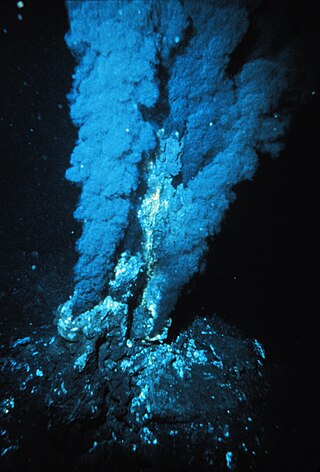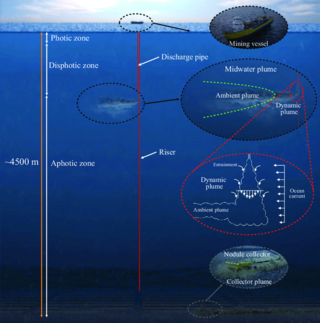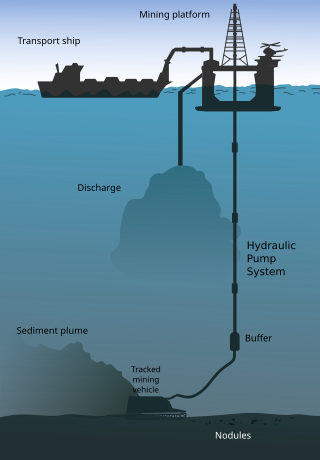
The International Seabed Authority (ISA) is a Kingston, Jamaica-based intergovernmental body of 167 member states and the European Union established under the 1982 UN Convention on the Law of the Sea (UNCLOS) and its 1994 Agreement on Implementation. The ISA's dual mission is to authorize and control development of mineral related operations in the international seabed considered the "common heritage of all mankind" and also protect the ecosystem of the seabed, ocean floor and subsoil in "The Area" beyond national jurisdiction. The ISA is to safeguard the international deep sea, the waters below 200 meters or 656 feet, where photosynthesis is hampered by inadequate light. Governing approximately half of the total area of the world's oceans, the ISA is to exercise oversight of activities that might threaten biological diversity and harm the marine environment. The Authority operates as an autonomous international organization with its own Assembly, Council and Secretariat.

Manganese is a chemical element; it has symbol Mn and atomic number 25. It is a hard, brittle, silvery metal, often found in minerals in combination with iron. Manganese was first isolated in the 1770s. Manganese is a transition metal with a multifaceted array of industrial alloy uses, particularly in stainless steels. It improves strength, workability, and resistance to wear. Manganese oxide is used as an oxidising agent; as a rubber additive; and in glass making, fertilisers, and ceramics. Manganese sulfate can be used as a fungicide.

Ore is natural rock or sediment that contains one or more valuable minerals concentrated above background levels, typically containing metals, that can be mined, treated and sold at a profit. The grade of ore refers to the concentration of the desired material it contains. The value of the metals or minerals a rock contains must be weighed against the cost of extraction to determine whether it is of sufficiently high grade to be worth mining and is therefore considered an ore. A complex ore is one containing more than one valuable mineral.

Hydrothermal vents are fissures on the seabed from which geothermally heated water discharges. They are commonly found near volcanically active places, areas where tectonic plates are moving apart at mid-ocean ridges, ocean basins, and hotspots. The dispersal of hydrothermal fluids throughout the global ocean at active vent sites creates hydrothermal plumes. Hydrothermal deposits are rocks and mineral ore deposits formed by the action of hydrothermal vents.

An abyssal plain is an underwater plain on the deep ocean floor, usually found at depths between 3,000 and 6,000 metres. Lying generally between the foot of a continental rise and a mid-ocean ridge, abyssal plains cover more than 50% of the Earth's surface. They are among the flattest, smoothest, and least explored regions on Earth. Abyssal plains are key geologic elements of oceanic basins.

The seabed is the bottom of the ocean. All floors of the ocean are known as 'seabeds'.

Birnessite (nominally MnO2·nH2O), also known as δ-MnO2, is a hydrous manganese dioxide mineral with a chemical formula of Na0.7Ca0.3Mn7O14·2.8H2O. It is the main manganese mineral species at the Earth's surface, and commonly occurs as fine-grained, poorly crystallized aggregates in soils, sediments, grain and rock coatings (e.g., desert varnish), and marine ferromanganese nodules and crusts. It was discovered at Birness, Aberdeenshire, Scotland.

The National Institute of Ocean Technology (NIOT) was established in November 1993 as an autonomous society under the Ministry of Earth Sciences in India. NIOT is managed by a Governing Council and is headed by a director. The institute is based in Chennai. The major aim of starting NIOT was to develop reliable indigenous technologies to solve various engineering problems associated with harvesting of non-living and living resources in India's exclusive economic zone, which is about two-thirds of the land area of India.

In sedimentology and geology, a nodule is a small, irregularly rounded knot, mass, or lump of a mineral or mineral aggregate that typically has a contrasting composition, such as a pyrite nodule in coal, a chert nodule in limestone, or a phosphorite nodule in marine shale, from the enclosing sediment or sedimentary rock. Normally, a nodule has a warty or knobby surface and exists as a discrete mass within the host strata. In general, they lack any internal structure except for the preserved remnants of original bedding or fossils. Nodules are closely related to concretions and sometimes these terms are used interchangeably. Minerals that typically form nodules include calcite, chert, apatite (phosphorite), anhydrite, and pyrite.

Deep sea mining is the extraction of minerals from the ocean floor at depths of 200 metres (660 ft) to 6,500 metres (21,300 ft).

Marine sediment, or ocean sediment, or seafloor sediment, are deposits of insoluble particles that have accumulated on the seafloor. These particles either have their origins in soil and rocks and have been transported from the land to the sea, mainly by rivers but also by dust carried by wind and by the flow of glaciers into the sea, or they are biogenic deposits from marine organisms or from chemical precipitation in seawater, as well as from underwater volcanoes and meteorite debris.

Natural resource economics deals with the supply, demand, and allocation of the Earth's natural resources. One main objective of natural resource economics is to better understand the role of natural resources in the economy in order to develop more sustainable methods of managing those resources to ensure their availability for future generations. Resource economists study interactions between economic and natural systems, with the goal of developing a sustainable and efficient economy.
Nii Allotey Odunton, a mining engineer from Ghana, was the Secretary-General of the International Seabed Authority, serving consecutive four-year terms starting in 2009 and ending in 2017.

The Clarion-Clipperton Zone (CCZ) or Clarion-Clipperton Fracture Zone is an environmental management area of the Pacific Ocean, administered by the International Seabed Authority (ISA). It includes the Clarion Fracture Zone and the Clipperton Fracture Zone, geological submarine fracture zones. Clarion and Clipperton are two of the five major lineations of the northern Pacific floor, and were discovered by the Scripps Institution of Oceanography in 1954. The CCZ is regularly considered for deep-sea mining due to the abundant presence of manganese nodules.

Ita Mai Tai is a Cretaceous-early Cenozoic seamount northwest of the Marshall Islands and north of Micronesia. One among a number of seamounts in the Pacific Ocean, it is part of the Magellan Seamounts which may have a hotspot origin although Ita Mai Tai itself may not have formed on a hotspot.
Deep Ocean mission is an Indian initiative to undertake the deep ocean exploration focused on India's exclusive economic zones and continental shelf. The program will consist of various crewed and uncrewed submersibles exploring the sea bed. One of the primary aims of the mission is to explore and extract polymetallic nodules, which are composed of minerals like manganese, nickel, cobalt, copper and iron hydroxide. The metals can be used in the manufacturing of electronic devices, smartphones, batteries and solar panels.

Seabed mining, also known as Seafloor mining is the recovery of minerals from the seabed by techniques of underwater mining. The concept includes mining at shallow depths on the continental shelf and deep-sea mining at greater depths associated with tectonic activity, hydrothermal vents and the abyssal plains. The increased requirement for minerals and metals used in the technology sector has led to a renewed interest in the mining of seabed mineral resources, including massive polymetallic sulfide deposits around hydrothermal vents, cobalt-rich crusts on the sides of seamounts and fields of manganese nodules on the abyssal plains. While the seabed provides a high concentration of valuable minerals, there is an unknown risk of ecological damage on marine species because of a lack of data.
The Metals Company, formerly DeepGreen Metals, is a Canadian deep sea mining exploration company. The company focuses on the mining of polymetallic (manganese) nodules.

Namibia is one of the first countries that issued mining licences regarding deep sea mining. studies that took place in 1970s discovered considerable amounts of phosphate deposits. The significance of seabed mining in Namibia's blue economy is highlighted by the country's status as a "phosphate factory". This is due to the exceptional upwellings of the Benguela Current ecosystem, a transboundary ocean current that spans from South Africa in the south to Angola in the north, passing through Namibia. Those deposits were found in depths between 180 and 300 meters below the sea level. In 2011 the Namibian government issued licences regarding the exploitation of the seabed phosphate resources after the necessary Environmental Impact Assessments (EIAs). The action plan that stood out was that of Namibian Marine Phosphates (NMP), a joint venture formed in 2008 between two Australian-based companies, Minemakers and Union Resources and Namibian-based Tungeni Investments. The so-called Sandpiper phosphate mining project outlay was introduced in January 2012 along with environmental reports regarding the effect this operation would have on marine life as well as the fishing industry and water quality changes. Those phosphorite resources are being found in continental shelves and slopes in America, Northern Spain, Morocco, Namibia, and South Africa which show a high potential for exploration.
On 25 June 2021, the president of Nauru, Lionel Aingimea, made a formal request to the president of the International Seabed Authority's (ISA) council to complete the adoption of rules, regulations and procedures necessary to facilitate the approval of plans of work for exploitation of deep-sea resources in the Area. This request is based on the "2-year rule", which is part of a provision from the 1994 Agreement relating to the Implementation of Part XI of the United Nations Convention on the Law of the Sea. The provision can be found in section 1 of the annex, and it states that the ISA must complete the adoption of rules, regulations and procedures for the approval of the exploitation of deep-sea minerals within 2 years of the request. The ISA's current deadline for drafting new regulation is set in July 2023, although some claim that this is not a "hard" or "fixed" deadline. Due to the issue's complexity, negotiations have thus far failed to come to a concrete agreement. Even if it fails to set clear standards for deep-sea mining activities, the ISA must consider applications for exploitation in waters outside national jurisdictions and provisionally approve contracts after July 2023. Many experts fear that deep-sea mining activities that are not adequately regulated could significantly impact the marine environment, the economies of many nations and the livelihoods of indigenous groups who depend on the oceans for survival.





















